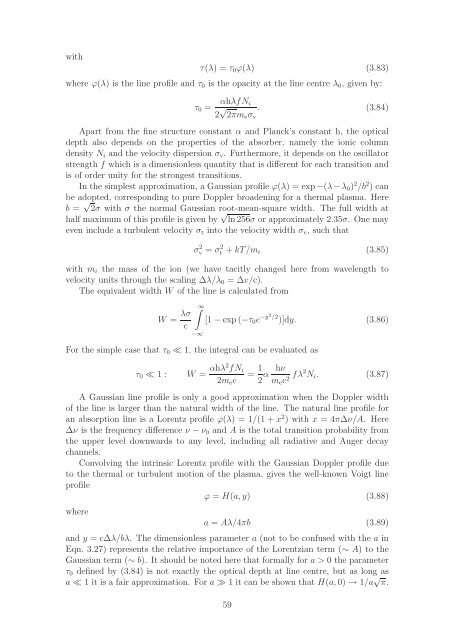Thermal X-ray radiation (PDF) - SRON
Thermal X-ray radiation (PDF) - SRON
Thermal X-ray radiation (PDF) - SRON
Create successful ePaper yourself
Turn your PDF publications into a flip-book with our unique Google optimized e-Paper software.
with<br />
τ(λ) = τ 0 ϕ(λ) (3.83)<br />
where ϕ(λ) is the line profile and τ 0 is the opacity at the line centre λ 0 , given by:<br />
τ 0 = αhλfN i<br />
2 √ 2πm e σ v<br />
. (3.84)<br />
Apart from the fine structure constant α and Planck’s constant h, the optical<br />
depth also depends on the properties of the absorber, namely the ionic column<br />
density N i and the velocity dispersion σ v . Furthermore, it depends on the oscillator<br />
strength f which is a dimensionless quantity that is different for each transition and<br />
is of order unity for the strongest transitions.<br />
In the simplest approximation, a Gaussian profile ϕ(λ) = exp −(λ−λ 0 ) 2 /b 2 ) can<br />
be adopted, corresponding to pure Doppler broadening for a thermal plasma. Here<br />
b = √ 2σ with σ the normal Gaussian root-mean-square width. The full width at<br />
half maximum of this profile is given by √ ln 256σ or approximately 2.35σ. One may<br />
even include a turbulent velocity σ t into the velocity width σ v , such that<br />
σ 2 v = σ 2 t + kT/m i (3.85)<br />
with m i the mass of the ion (we have tacitly changed here from wavelength to<br />
velocity units through the scaling ∆λ/λ 0 = ∆v/c).<br />
The equivalent width W of the line is calculated from<br />
W = λσ c<br />
∫ ∞<br />
[1 − exp (−τ 0 e −y2 /2 )]dy. (3.86)<br />
−∞<br />
For the simple case that τ 0 ≪ 1, the integral can be evaluated as<br />
τ 0 ≪ 1 :<br />
W = αhλ2 fN i<br />
2m e c<br />
= 1 2 α hν<br />
m e c 2 fλ2 N i . (3.87)<br />
A Gaussian line profile is only a good approximation when the Doppler width<br />
of the line is larger than the natural width of the line. The natural line profile for<br />
an absorption line is a Lorentz profile ϕ(λ) = 1/(1 + x 2 ) with x = 4π∆ν/A. Here<br />
∆ν is the frequency difference ν − ν 0 and A is the total transition probability from<br />
the upper level downwards to any level, including all radiative and Auger decay<br />
channels.<br />
Convolving the intrinsic Lorentz profile with the Gaussian Doppler profile due<br />
to the thermal or turbulent motion of the plasma, gives the well-known Voigt line<br />
profile<br />
ϕ = H(a, y) (3.88)<br />
where<br />
a = Aλ/4πb (3.89)<br />
and y = c∆λ/bλ. The dimensionless parameter a (not to be confused with the a in<br />
Eqn. 3.27) represents the relative importance of the Lorentzian term (∼ A) to the<br />
Gaussian term (∼ b). It should be noted here that formally for a > 0 the parameter<br />
τ 0 defined by (3.84) is not exactly the optical depth at line centre, but as long as<br />
a ≪ 1 it is a fair approximation. For a ≫ 1 it can be shown that H(a, 0) → 1/a √ π.<br />
59
















